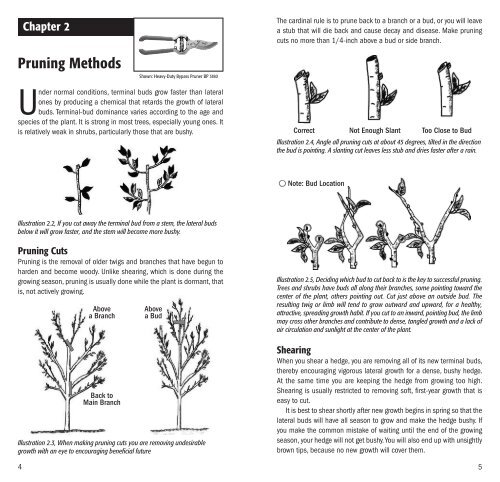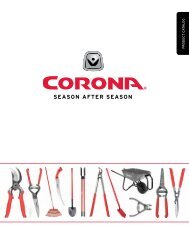Pruning Principles 2009 - Corona Tools
Pruning Principles 2009 - Corona Tools
Pruning Principles 2009 - Corona Tools
Create successful ePaper yourself
Turn your PDF publications into a flip-book with our unique Google optimized e-Paper software.
Chapter 2<br />
The cardinal rule is to prune back to a branch or a bud, or you will leave<br />
a stub that will die back and cause decay and disease. Make pruning<br />
cuts no more than 1/4-inch above a bud or side branch.<br />
<strong>Pruning</strong> Methods<br />
Shown: Heavy-Duty Bypass Pruner BP 3180<br />
Under normal conditions, terminal buds grow faster than lateral<br />
ones by producing a chemical that retards the growth of lateral<br />
buds. Terminal-bud dominance varies according to the age and<br />
species of the plant. It is strong in most trees, especially young ones. It<br />
is relatively weak in shrubs, particularly those that are bushy.<br />
Correct Not Enough Slant Too Close to Bud<br />
Illustration 2.4, Angle all pruning cuts at about 45 degrees, tilted in the direction<br />
the bud is pointing. A slanting cut leaves less stub and dries faster after a rain.<br />
Note: Bud Location<br />
Illustration 2.2, If you cut away the terminal bud from a stem, the lateral buds<br />
below it will grow faster, and the stem will become more bushy.<br />
<strong>Pruning</strong> Cuts<br />
<strong>Pruning</strong> is the removal of older twigs and branches that have begun to<br />
harden and become woody. Unlike shearing, which is done during the<br />
growing season, pruning is usually done while the plant is dormant, that<br />
is, not actively growing.<br />
Illustration 2.3, When making pruning cuts you are removing undesirable<br />
growth with an eye to encouraging beneficial future<br />
4<br />
Above<br />
a Branch<br />
Back to<br />
Main Branch<br />
Above<br />
a Bud<br />
Illustration 2.5, Deciding which bud to cut back to is the key to successful pruning.<br />
Trees and shrubs have buds all along their branches, some pointing toward the<br />
center of the plant, others pointing out. Cut just above an outside bud. The<br />
resulting twig or limb will tend to grow outward and upward, for a healthy,<br />
attractive, spreading growth habit. If you cut to an inward, pointing bud, the limb<br />
may cross other branches and contribute to dense, tangled growth and a lack of<br />
air circulation and sunlight at the center of the plant.<br />
Shearing<br />
When you shear a hedge, you are removing all of its new terminal buds,<br />
thereby encouraging vigorous lateral growth for a dense, bushy hedge.<br />
At the same time you are keeping the hedge from growing too high.<br />
Shearing is usually restricted to removing soft, first-year growth that is<br />
easy to cut.<br />
It is best to shear shortly after new growth begins in spring so that the<br />
lateral buds will have all season to grow and make the hedge bushy. If<br />
you make the common mistake of waiting until the end of the growing<br />
season, your hedge will not get bushy.You will also end up with unsightly<br />
brown tips, because no new growth will cover them.<br />
5



